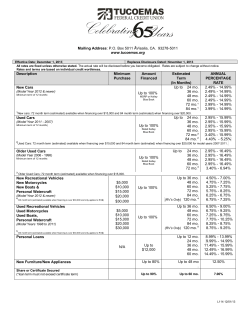
Homework #3 Answer Key Econ 435 Fall 2014 Prof. Eschker
Homework #3 Answer Key Econ 435 Fall 2014 Prof. Eschker Due Wednesday, October 15 at the start of class Turn in answers ONLY, not the questions. Show your work. 1. a. You are hiring an employee, and you advertise the position for $30,000. If someone offers to work for $25,000, should you hire her? Paying a salary of $25,000 is only a good deal for the firm if the applicant is as productive as another worker who gets paid the advertised salary of $30,000. If the firm is hiring the worker for a job that is hard to monitor, then the worker who gets paid the lower-than-advertised salary is more prone to goofing off. The moral hazard problem is more pronounced at the lower salary. Also, the fact that the worker volunteered to take a lower salary may indicate that this worker does not plan to work very hard in the first place. The willingness to accept a lower salary matches the worker’s knowledge of his or her productivity and indicates an adverse selection problem. In either case, the firm needs to consider both moral hazard and adverse selection problems before jumping at the offer of paying a lower salary. b. Suppose you are going to lend $1,000 at 5% interest, and someone offers to pay 10% interest. Should you take the offer? The person offering to pay 10 percent may be engaged in a highly risky venture that pays high returns if successful, but has a high probability of failure and default. In the case of default, the person will not be able to pay any interest or principle. Thus, the promise to pay a higher interest rate should be regarded with caution. It is likely that adverse selection is a problem here. 2. Consider a variation of the example of adverse selection we did in class. The safe firm undertakes the safe project, which earns $12,000 all the time. The risky firm undertakes the risky project, which earns $22,000 ½ of the time and $0 ½ of the time. Suppose that a bank is willing to lend but it needs to get repaid $10,000 on average if the project is successful. In other words, the bank sets the payment if successful according to the following: $10,000 = (probability of success) * (payment if successful) a. If the bank knows which firm is safe, how much payment will the bank want from the safe firm if the project is successful? Will the safe firm be able to pay this? The bank wants 10,000=1*(payment if successful), so payment if successful = $10,000 Yes, the safe firm can pay this, since it earns $12,000 b. If the bank knows which firm is risky, how much payment will the bank want from the risky firm if the project is successful? Will the risky firm be able to pay this? The bank wants 10,000=1/2*(payment if successful), so payment if successful = $20,000 Yes, the risky firm can pay this, since it earns $22,000 when successful. c. If the firm can’t tell which firm is risky and which is safe (asymmetric information), then what is the probability of success it assumes for each firm? Using this probability of success, how much payment will the bank want from each firm? The bank uses the average probability of success for the safe and risky firms, which is (1+1/2)/2 =¾ For all firms, the bank wants 10,000=(3/4)*(payment if successful), so payment if successful = $13,333 d. Will the safe firm pay this? Will the risky? The safe firm will not, since 13,333>12,000 The risk firm will pay it, since 13,333<22,000 e. With asymmetric information, which firms are left taking out loans, and are there any firms that will agree to the loan payment if successful? The risky firms are all that are left from part d) The bank quickly realizes this, and uses the risky firm probability of success, which is ½ Then the bank requires the payment from part b), and as we saw in part b), the risky firm is willing to pay this. 3. Consider a variation of the collateral example we did in class. Suppose that a safe project earns $1,500 and a risky project earns $2,000 half of the time and $0 half of the time. Suppose that the firm borrows to fund the project, and that the bank needs to be repaid $1,200 for the loan. If the project earns $0, then the firm defaults on the payment. a. How much does the firm get to keep, after repaying the loan, if it chooses the safe project? How much does the bank get? Firm gets $1,500 - $1,200 = $300 Bank gets $1,200 b. How much does the firm get to keep, after repaying the loan, if it chooses the risky project? How much does the bank get? Hint: you need to calculate expected payment = (Probability of Success)*(Payment if successful) + (Probability of default)*(Payment if default) Firm gets $2,000-$1,200 = $800 half of the time, and $0 half of the time, so Expected payment = ½*800 + ½*0 =$400 Bank gets $1,200 half of the time, $0 half of the time, so Expected payment = ½*1,200 + ½*0 = $600 c. Does the firm prefer the risky or safe project? What does the bank prefer? The firm wants risky because $400>$300 The bank wants safe because $1,200>$600 d. What is the smallest level of collateral the causes the firm to choose the safe project? Recall that collateral lowers expected payment if there is default, since the bank takes collateral from the firm. With collateral, Expected payment = ½*800 + ½*(-collateral) . Hint: What level of collateral gives the same expected amount to the firm as calculated in part a)? ½*800 + ½*(-collateral) = $300 Just use algebra to solve for collateral Collateral = $200 4. Suppose that Fang’s Bank purchases Alexei’s Bank, making Alexei a subsidiary of Fang. Does this acquisition benefit the stockholders of Fang’s Bank? Does the answer depend on the motives for the purchase? Explain. (Hint: Review the motives for bank consolidation discussed in Section 8.2.) The motives for consolidation are economies of scale, diversification, and empire building. If the motive for consolidation is either economies of scale or diversification, then Fang’s shareholders should gain because profits for Fang’s Bank should be higher (economies of scale) or more stable (diversification) than before the merger. If the motive for the merger is empire building, then Fang’s profits may be unchanged or even lower. This type of merger does not benefit Fang’s shareholders. 5. Securitization has spread from mortgages to student loans and credit card debt. However, few loans to businesses have been securitized. Explain why. Securitization relies on a bundling or pooling of loans that share similar characteristics, such as credit scores for mortgage loans or car loans. Pooling based on specific characteristics allows savers to gauge the default risk of the securities that give them access to a share of the payments on the loan pool. Since it is harder to find similar characteristics for businesses than for households, it would be harder to gauge the default risk of a security based on business loans. This will drive down the price of these securities, making it less or not at all profitable for banks to securitize business loans.
© Copyright 2025












